BUS-FP3040: Compensation and Benefits Package for Java Corp
VerifiedAdded on 2022/08/13
|5
|1414
|8
Project
AI Summary
This project presents a detailed compensation and benefits package designed for an expatriate position within Java Corp, a coffee and iced tea company. The package addresses key components such as base pay, outlining considerations for strategic variables, organizational positioning, and alignment with industry standards, including the use of incentive pay and hardship allowances. The project further explores legally mandated benefits and employer-provided options, such as home leave benefits and tax equalization, while also detailing benefit plans like 401k, insurance, and workers' compensation. It also examines the importance of additional benefits in attracting and retaining employees, especially in the context of expatriate positions, and the need for a strategic approach to compensation planning. The document references relevant literature to support the analysis and recommendations.
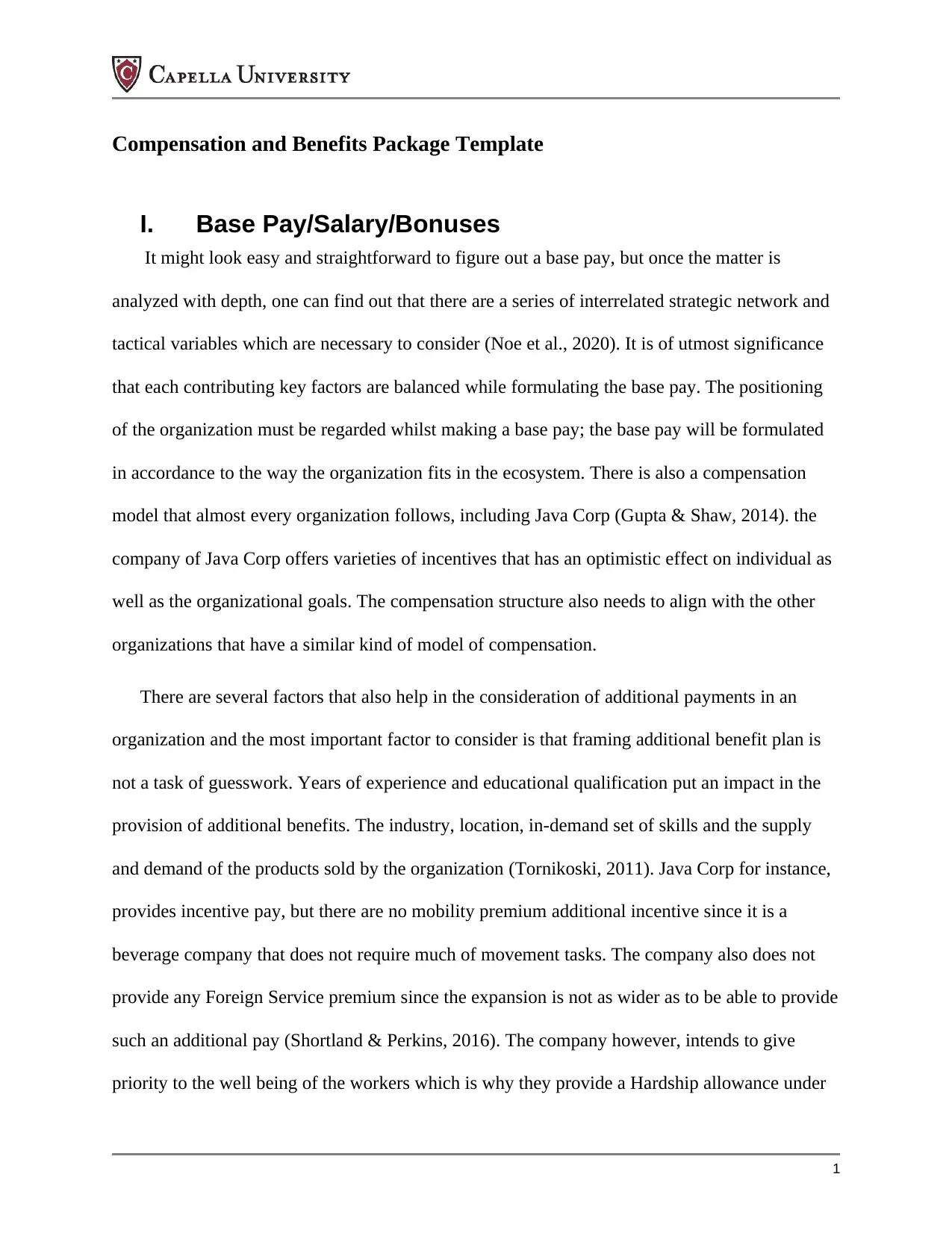
Compensation and Benefits Package Template
I. Base Pay/Salary/Bonuses
It might look easy and straightforward to figure out a base pay, but once the matter is
analyzed with depth, one can find out that there are a series of interrelated strategic network and
tactical variables which are necessary to consider (Noe et al., 2020). It is of utmost significance
that each contributing key factors are balanced while formulating the base pay. The positioning
of the organization must be regarded whilst making a base pay; the base pay will be formulated
in accordance to the way the organization fits in the ecosystem. There is also a compensation
model that almost every organization follows, including Java Corp (Gupta & Shaw, 2014). the
company of Java Corp offers varieties of incentives that has an optimistic effect on individual as
well as the organizational goals. The compensation structure also needs to align with the other
organizations that have a similar kind of model of compensation.
There are several factors that also help in the consideration of additional payments in an
organization and the most important factor to consider is that framing additional benefit plan is
not a task of guesswork. Years of experience and educational qualification put an impact in the
provision of additional benefits. The industry, location, in-demand set of skills and the supply
and demand of the products sold by the organization (Tornikoski, 2011). Java Corp for instance,
provides incentive pay, but there are no mobility premium additional incentive since it is a
beverage company that does not require much of movement tasks. The company also does not
provide any Foreign Service premium since the expansion is not as wider as to be able to provide
such an additional pay (Shortland & Perkins, 2016). The company however, intends to give
priority to the well being of the workers which is why they provide a Hardship allowance under
1
I. Base Pay/Salary/Bonuses
It might look easy and straightforward to figure out a base pay, but once the matter is
analyzed with depth, one can find out that there are a series of interrelated strategic network and
tactical variables which are necessary to consider (Noe et al., 2020). It is of utmost significance
that each contributing key factors are balanced while formulating the base pay. The positioning
of the organization must be regarded whilst making a base pay; the base pay will be formulated
in accordance to the way the organization fits in the ecosystem. There is also a compensation
model that almost every organization follows, including Java Corp (Gupta & Shaw, 2014). the
company of Java Corp offers varieties of incentives that has an optimistic effect on individual as
well as the organizational goals. The compensation structure also needs to align with the other
organizations that have a similar kind of model of compensation.
There are several factors that also help in the consideration of additional payments in an
organization and the most important factor to consider is that framing additional benefit plan is
not a task of guesswork. Years of experience and educational qualification put an impact in the
provision of additional benefits. The industry, location, in-demand set of skills and the supply
and demand of the products sold by the organization (Tornikoski, 2011). Java Corp for instance,
provides incentive pay, but there are no mobility premium additional incentive since it is a
beverage company that does not require much of movement tasks. The company also does not
provide any Foreign Service premium since the expansion is not as wider as to be able to provide
such an additional pay (Shortland & Perkins, 2016). The company however, intends to give
priority to the well being of the workers which is why they provide a Hardship allowance under
1
Paraphrase This Document
Need a fresh take? Get an instant paraphrase of this document with our AI Paraphraser
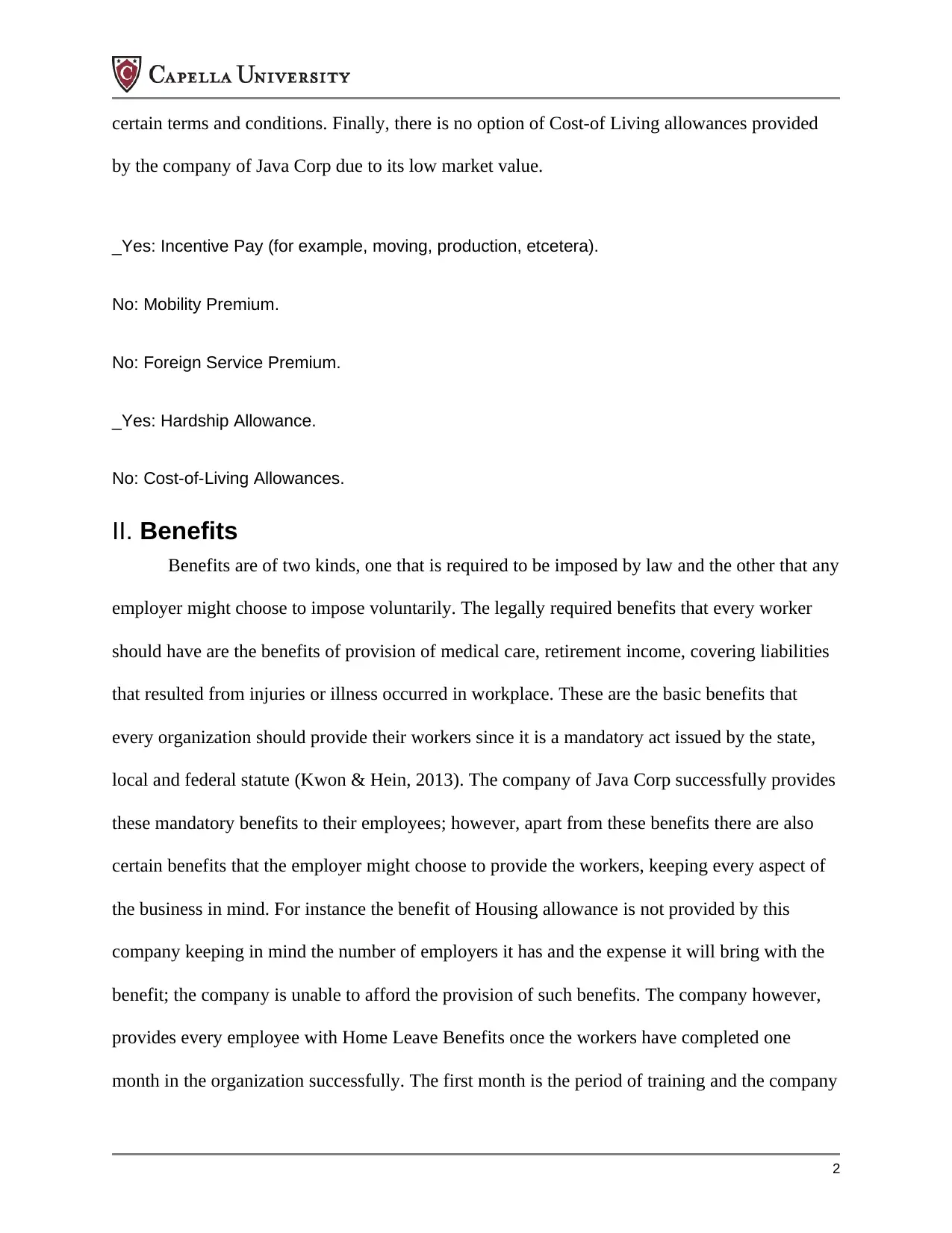
certain terms and conditions. Finally, there is no option of Cost-of Living allowances provided
by the company of Java Corp due to its low market value.
_Yes: Incentive Pay (for example, moving, production, etcetera).
No: Mobility Premium.
No: Foreign Service Premium.
_Yes: Hardship Allowance.
No: Cost-of-Living Allowances.
II. Benefits
Benefits are of two kinds, one that is required to be imposed by law and the other that any
employer might choose to impose voluntarily. The legally required benefits that every worker
should have are the benefits of provision of medical care, retirement income, covering liabilities
that resulted from injuries or illness occurred in workplace. These are the basic benefits that
every organization should provide their workers since it is a mandatory act issued by the state,
local and federal statute (Kwon & Hein, 2013). The company of Java Corp successfully provides
these mandatory benefits to their employees; however, apart from these benefits there are also
certain benefits that the employer might choose to provide the workers, keeping every aspect of
the business in mind. For instance the benefit of Housing allowance is not provided by this
company keeping in mind the number of employers it has and the expense it will bring with the
benefit; the company is unable to afford the provision of such benefits. The company however,
provides every employee with Home Leave Benefits once the workers have completed one
month in the organization successfully. The first month is the period of training and the company
2
by the company of Java Corp due to its low market value.
_Yes: Incentive Pay (for example, moving, production, etcetera).
No: Mobility Premium.
No: Foreign Service Premium.
_Yes: Hardship Allowance.
No: Cost-of-Living Allowances.
II. Benefits
Benefits are of two kinds, one that is required to be imposed by law and the other that any
employer might choose to impose voluntarily. The legally required benefits that every worker
should have are the benefits of provision of medical care, retirement income, covering liabilities
that resulted from injuries or illness occurred in workplace. These are the basic benefits that
every organization should provide their workers since it is a mandatory act issued by the state,
local and federal statute (Kwon & Hein, 2013). The company of Java Corp successfully provides
these mandatory benefits to their employees; however, apart from these benefits there are also
certain benefits that the employer might choose to provide the workers, keeping every aspect of
the business in mind. For instance the benefit of Housing allowance is not provided by this
company keeping in mind the number of employers it has and the expense it will bring with the
benefit; the company is unable to afford the provision of such benefits. The company however,
provides every employee with Home Leave Benefits once the workers have completed one
month in the organization successfully. The first month is the period of training and the company
2
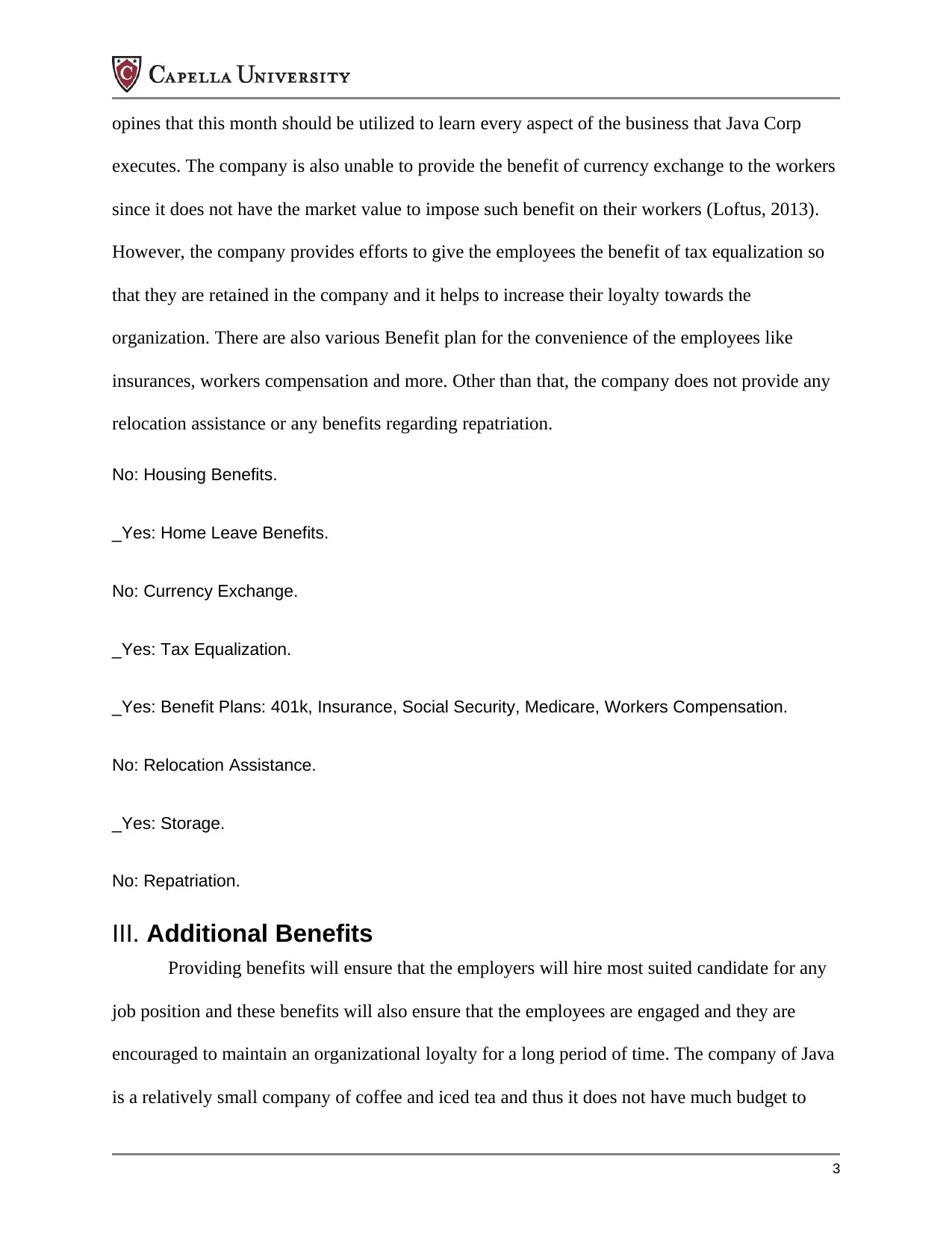
opines that this month should be utilized to learn every aspect of the business that Java Corp
executes. The company is also unable to provide the benefit of currency exchange to the workers
since it does not have the market value to impose such benefit on their workers (Loftus, 2013).
However, the company provides efforts to give the employees the benefit of tax equalization so
that they are retained in the company and it helps to increase their loyalty towards the
organization. There are also various Benefit plan for the convenience of the employees like
insurances, workers compensation and more. Other than that, the company does not provide any
relocation assistance or any benefits regarding repatriation.
No: Housing Benefits.
_Yes: Home Leave Benefits.
No: Currency Exchange.
_Yes: Tax Equalization.
_Yes: Benefit Plans: 401k, Insurance, Social Security, Medicare, Workers Compensation.
No: Relocation Assistance.
_Yes: Storage.
No: Repatriation.
III. Additional Benefits
Providing benefits will ensure that the employers will hire most suited candidate for any
job position and these benefits will also ensure that the employees are engaged and they are
encouraged to maintain an organizational loyalty for a long period of time. The company of Java
is a relatively small company of coffee and iced tea and thus it does not have much budget to
3
executes. The company is also unable to provide the benefit of currency exchange to the workers
since it does not have the market value to impose such benefit on their workers (Loftus, 2013).
However, the company provides efforts to give the employees the benefit of tax equalization so
that they are retained in the company and it helps to increase their loyalty towards the
organization. There are also various Benefit plan for the convenience of the employees like
insurances, workers compensation and more. Other than that, the company does not provide any
relocation assistance or any benefits regarding repatriation.
No: Housing Benefits.
_Yes: Home Leave Benefits.
No: Currency Exchange.
_Yes: Tax Equalization.
_Yes: Benefit Plans: 401k, Insurance, Social Security, Medicare, Workers Compensation.
No: Relocation Assistance.
_Yes: Storage.
No: Repatriation.
III. Additional Benefits
Providing benefits will ensure that the employers will hire most suited candidate for any
job position and these benefits will also ensure that the employees are engaged and they are
encouraged to maintain an organizational loyalty for a long period of time. The company of Java
is a relatively small company of coffee and iced tea and thus it does not have much budget to
3
⊘ This is a preview!⊘
Do you want full access?
Subscribe today to unlock all pages.

Trusted by 1+ million students worldwide
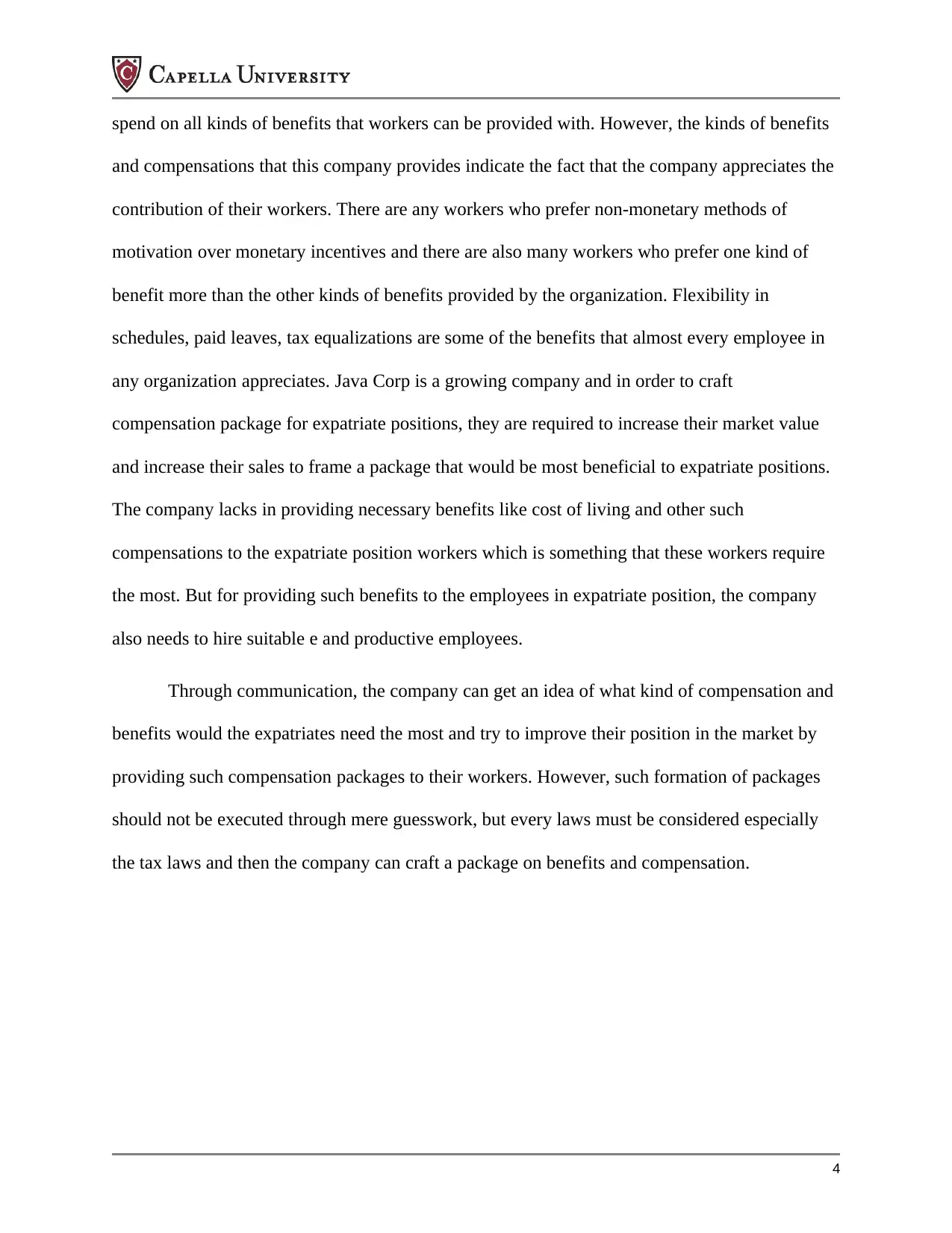
spend on all kinds of benefits that workers can be provided with. However, the kinds of benefits
and compensations that this company provides indicate the fact that the company appreciates the
contribution of their workers. There are any workers who prefer non-monetary methods of
motivation over monetary incentives and there are also many workers who prefer one kind of
benefit more than the other kinds of benefits provided by the organization. Flexibility in
schedules, paid leaves, tax equalizations are some of the benefits that almost every employee in
any organization appreciates. Java Corp is a growing company and in order to craft
compensation package for expatriate positions, they are required to increase their market value
and increase their sales to frame a package that would be most beneficial to expatriate positions.
The company lacks in providing necessary benefits like cost of living and other such
compensations to the expatriate position workers which is something that these workers require
the most. But for providing such benefits to the employees in expatriate position, the company
also needs to hire suitable e and productive employees.
Through communication, the company can get an idea of what kind of compensation and
benefits would the expatriates need the most and try to improve their position in the market by
providing such compensation packages to their workers. However, such formation of packages
should not be executed through mere guesswork, but every laws must be considered especially
the tax laws and then the company can craft a package on benefits and compensation.
4
and compensations that this company provides indicate the fact that the company appreciates the
contribution of their workers. There are any workers who prefer non-monetary methods of
motivation over monetary incentives and there are also many workers who prefer one kind of
benefit more than the other kinds of benefits provided by the organization. Flexibility in
schedules, paid leaves, tax equalizations are some of the benefits that almost every employee in
any organization appreciates. Java Corp is a growing company and in order to craft
compensation package for expatriate positions, they are required to increase their market value
and increase their sales to frame a package that would be most beneficial to expatriate positions.
The company lacks in providing necessary benefits like cost of living and other such
compensations to the expatriate position workers which is something that these workers require
the most. But for providing such benefits to the employees in expatriate position, the company
also needs to hire suitable e and productive employees.
Through communication, the company can get an idea of what kind of compensation and
benefits would the expatriates need the most and try to improve their position in the market by
providing such compensation packages to their workers. However, such formation of packages
should not be executed through mere guesswork, but every laws must be considered especially
the tax laws and then the company can craft a package on benefits and compensation.
4
Paraphrase This Document
Need a fresh take? Get an instant paraphrase of this document with our AI Paraphraser
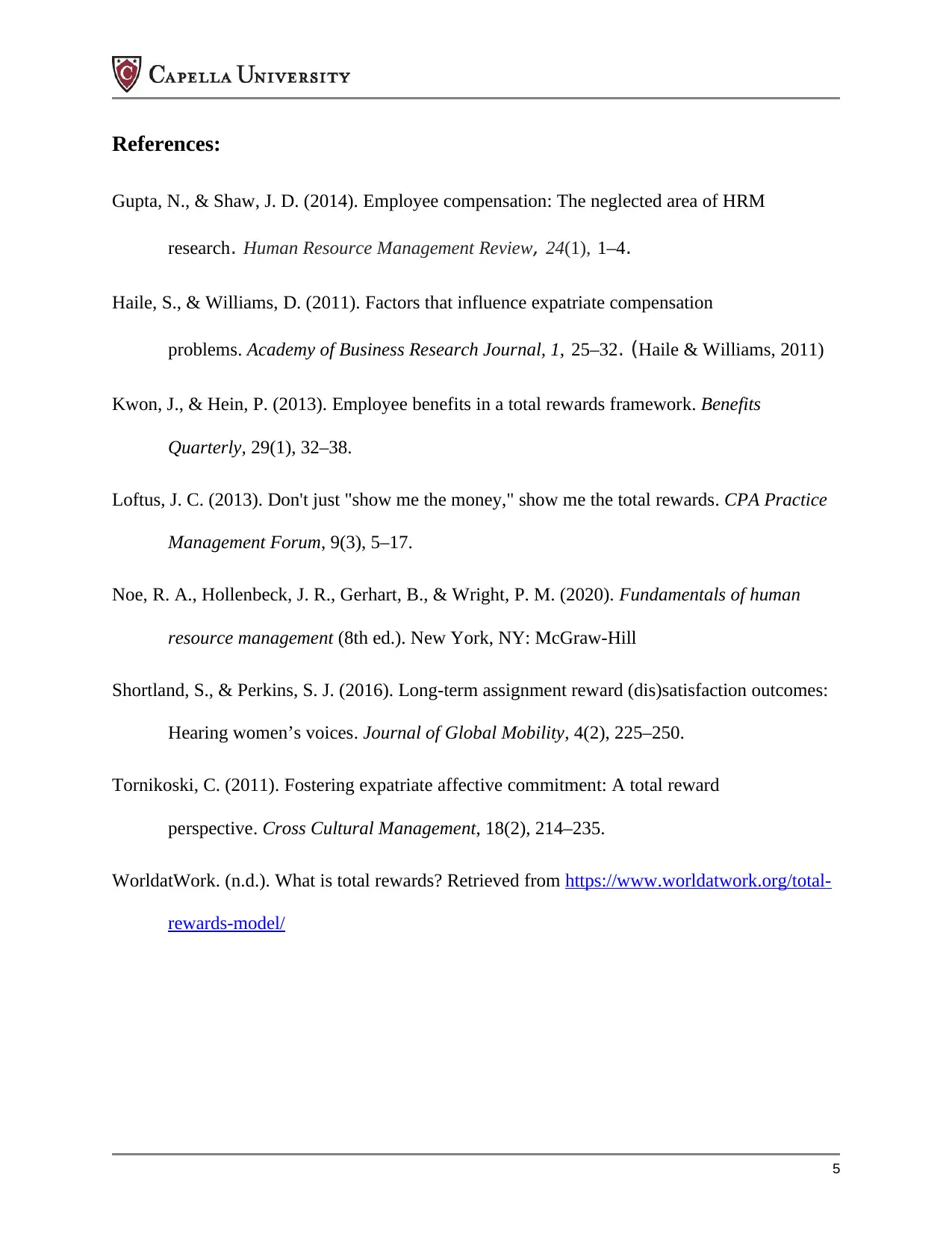
References:
Gupta, N., & Shaw, J. D. (2014). Employee compensation: The neglected area of HRM
research. Human Resource Management Review, 24(1), 1–4.
Haile, S., & Williams, D. (2011). Factors that influence expatriate compensation
problems. Academy of Business Research Journal, 1, 25–32. (Haile & Williams, 2011)
Kwon, J., & Hein, P. (2013). Employee benefits in a total rewards framework. Benefits
Quarterly, 29(1), 32–38.
Loftus, J. C. (2013). Don't just "show me the money," show me the total rewards. CPA Practice
Management Forum, 9(3), 5–17.
Noe, R. A., Hollenbeck, J. R., Gerhart, B., & Wright, P. M. (2020). Fundamentals of human
resource management (8th ed.). New York, NY: McGraw-Hill
Shortland, S., & Perkins, S. J. (2016). Long-term assignment reward (dis)satisfaction outcomes:
Hearing women’s voices. Journal of Global Mobility, 4(2), 225–250.
Tornikoski, C. (2011). Fostering expatriate affective commitment: A total reward
perspective. Cross Cultural Management, 18(2), 214–235.
WorldatWork. (n.d.). What is total rewards? Retrieved from https://www.worldatwork.org/total-
rewards-model/
5
Gupta, N., & Shaw, J. D. (2014). Employee compensation: The neglected area of HRM
research. Human Resource Management Review, 24(1), 1–4.
Haile, S., & Williams, D. (2011). Factors that influence expatriate compensation
problems. Academy of Business Research Journal, 1, 25–32. (Haile & Williams, 2011)
Kwon, J., & Hein, P. (2013). Employee benefits in a total rewards framework. Benefits
Quarterly, 29(1), 32–38.
Loftus, J. C. (2013). Don't just "show me the money," show me the total rewards. CPA Practice
Management Forum, 9(3), 5–17.
Noe, R. A., Hollenbeck, J. R., Gerhart, B., & Wright, P. M. (2020). Fundamentals of human
resource management (8th ed.). New York, NY: McGraw-Hill
Shortland, S., & Perkins, S. J. (2016). Long-term assignment reward (dis)satisfaction outcomes:
Hearing women’s voices. Journal of Global Mobility, 4(2), 225–250.
Tornikoski, C. (2011). Fostering expatriate affective commitment: A total reward
perspective. Cross Cultural Management, 18(2), 214–235.
WorldatWork. (n.d.). What is total rewards? Retrieved from https://www.worldatwork.org/total-
rewards-model/
5
1 out of 5
Related Documents
Your All-in-One AI-Powered Toolkit for Academic Success.
+13062052269
info@desklib.com
Available 24*7 on WhatsApp / Email
![[object Object]](/_next/static/media/star-bottom.7253800d.svg)
Unlock your academic potential
Copyright © 2020–2025 A2Z Services. All Rights Reserved. Developed and managed by ZUCOL.



